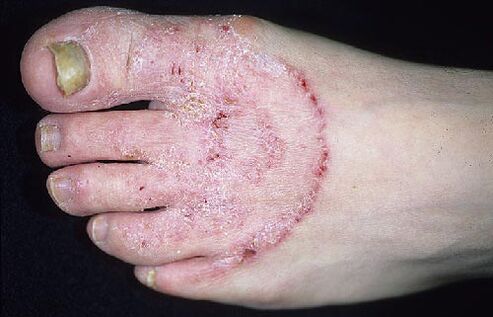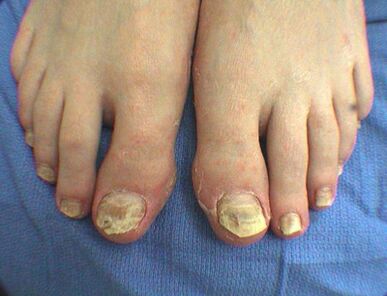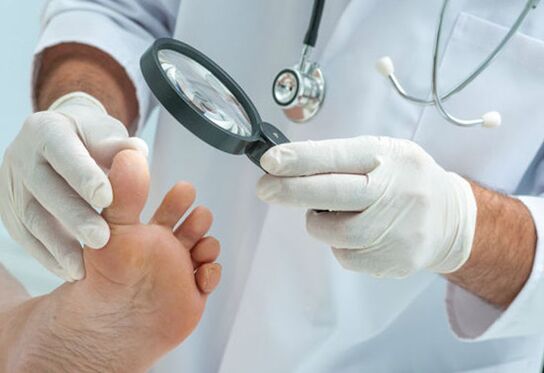The nail fungus (onychomycosis) is the most common disease in which the nails become yellow, become brittle and thick, are covered with cracks.In the early stages, the symptoms of nail fungi are barely noticeable.The treatment of the disease is difficult due to altered cell immunity.The disease takes place slowly, without appropriate treatment and can accompany the patient all his life.

Most often, the fungus of the nails is detected in a man and people with weakened immunity.Patients with diabetes, obesity, links with the pathology of blood vessels and skin diseases are subject to disease.With high sweat legs, there is more chances of fungal damage to the skin of the feet and nails on the legs.
The fungus can be put on the nail plates clothes, shoes, manicure sets, carpets, floor.It enters the nails by the microfissures of the skin and through the bed of the nail.This is a lot where it is hot and humid: in souls, baths, changing rooms and swimming pools.In healthy people, the disease rarely develops.
The cause of the disease
Onychomycosis is caused by three species of fungi (one by one or in combination).Most cases of the disease are caused by fungi of the type of trichophyton.Much less often - Trichophyton Interdigital, Epidermophyton Floccosum and Microsporum and Aspergillus.
- The yeast mushrooms of the type of candida albicans always parasitize on the skin and nails.Taking antibiotics, contraceptives and a decrease in immunity can develop yeast infection.
- Milling mushrooms often cause diseases in countries with tropical climate.
- The ground mushrooms live in the soil and only cause onchomycosis in some people.From one person to another are not transmitted.
Source of infection
- Family and friends diseases can become a source of pathogens for you.
The fungus is transmitted to the family by use by a common towel, slippers, bedding, etc. - The fungus on the hands can become a source of nail and skin skin disease.
- In large numbers, the fungus lives in the bathrooms, the shower and the swimming pools.
- The source of infection can be patient clothes and shoes, manicure sets, carpets and floors.
Which increases the risk of the disease
- The fungus of the skin of the feet.
- Reducing immunity.
- Family members suffering from fungal defeat.
- Age of the elderly.
- Diabetes.
- The presence of microtraumas and burrs.
- Increase in leg sweating.
- Unknown and poor shoes.
- The habit of walking barefoot in public places.
- Accommodation and work in a damp climate.
- Wearing artificial nails in the long term.
Which affects the development and progression of onychomycosis
- General health.
- Sensitivity to infection.
- The humidity and thermal background level.
- The type of nail plate (the nails on the fingers grow more slowly).

Nail fungi symptoms
At the start of the disease, the usual color of the nails changes.He becomes opaque.A gap in which the mushrooms itself appear between him and his bed.
The nail is painted in one of the colors: whitish gray, yellow, green and brown, to black.Yellow oblong stripes inside the nail and below are visible.Spots of different shades.
The nail thickens and deforms above the affected area.The horn masses are gradually developing, preventing the penetration of drugs.
At the beginning, increased fragility is also noted, when the fungus affects the entire nail plate, it begins to collapse and collapse.During treatment, a large amount of "garbage" made up of destroyed fragments and epidermis is formed.Often there are skin damage.
Onychomycosis forms
- Distal underwater onychomycosis.
- Lateral onychomycosis.
- White surface onychomycosis.
- Onychomycosis of the proximal tray.
- Total dystrophic onychomycosis.
Distal submarine and lateral onychomycosis
This form of the disease is the most common.Up to 90% of cases, its cause is mushrooms of the genus Trichophyton Rubrum.The infection of the nail plate begins in the free edge of the affected skin of the foot.First, the nail bed is affected.The type of damage looks like a burst or a stained yellowish color.With the progression of the disease, the nail thickens and can separate or separate from the skin.The distal underwater onychomycosis is difficult to treat.Wearing shoes causes discomfort.
White surface onychomycosis
The second most common form of onychomycosis.In 90% of cases, the disease is caused by the genus of the genus Trichophyton Interdutal, which only affects the upper layer of the nail plate, which never thickens and does not separate from the skin.Over time, its entire surface stands out, like chalk powder.The remedy occurs quickly.
Proximal onychomycosis
This form of onychomycosis is rare.Red trichophytes on blood and lymphatic paths spread throughout the body.This is highlighted by the rear nail damage (proximal) and the pathogen's detection in the lymph nodes of the inguinal region and the secretion of the prostate gland.The disease is often recorded in infected HIV.The defeat begins with the skin in the area of the nail fold, which thickens.In addition, the nail plate is involved in the process, which acquires an opaque white color.
Total dystrophic onychomycosis
This form of the disease is a consequence of the progression of one or a set of types of forms above onychomycosis.The nail plate is partially or completely destroyed.
Diseases with similar symptoms

Of all infectious diseases, onychomycosis is in 50% of cases.Similar symptoms are in the following diseases:
- Eczema.
- Psoriasis.
- Reuters syndrome.
- Daria's disease.
- Flat lichen.
- Norwegian Scabies.
Nail fungus diagnosis
In order to obtain information on what has caused certain changes, you must consult a dermatologist who organizes the diagnostic procedure for the disease.The scratching of the affected part will be sent to the laboratory to clarify the causes of the disease.
Microscopy will identify the presence of a fungus, and sowing on a nutritious environment will highlight the pure culture of the pathogen and determine sensitivity to antifungal drugs.
Before starting the treatment, it is necessary to identify the type of infection. The nails mushroom on the legs is easier to warn.Examine the feet and nails on your feet more often.The early beginning treatment will contribute to an improvement quickly, to reduce the feeling of discomfort and to eliminate the aesthetic effect.

























